Classical Art Depicting the Fall of Adam and Eve
If you've seen Phoebe Waller-Span's Killing Eve, you lot may accept noticed the symbolic inclusions of Adam and Eve or maybe fifty-fifty the protagonist's preferred snack of option – a juicy apple. So why did the scriptwriters of a evidence virtually an erotic obsession between a flawlessly dressed, psychopathic assassin (Villanelle, played by Jodie Comer) and an MI5 agent called Eve (played by Sandra Oh) brand reference to the Bible's oldest story?
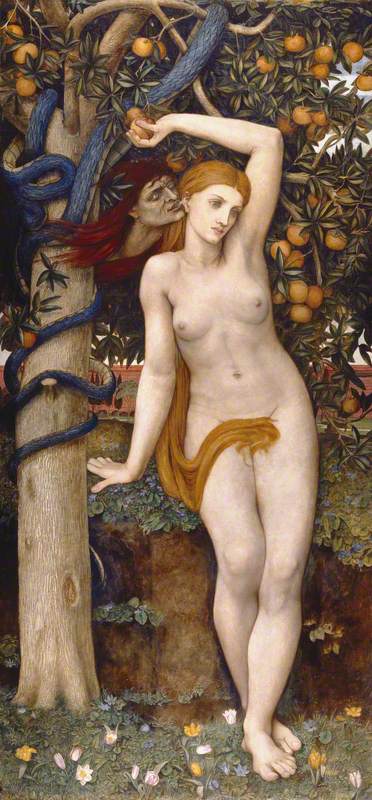
According to the creation story in the Volume of Genesis, the first woman – Eve – was responsible for the 'autumn of man' and killing our mortal souls when she ate the forbidden fruit in the Garden of Eden. Because of her bad (and rather fruity) behaviour, Eve is ane of the most painted women in western art history. She is a complicated archetype who represents desire, shame and original sin. Her story is deeply rooted in the psyche of western civilisation and art history.
In an historic period that celebrates relatable female characters who brand mistakes (like Sandra Oh's Eve Polastri), or obversely 'nasty woman' and villainous antagonists who undermine traditional notions of femininity (like Jody Comer's Villanelle), allow's reassess the complex figure of Eve – the original bad daughter.
Firstly, let'southward take a look at whether the symbolic figure of Eve originated in the biblical cosmos story.
You may exist intrigued to learn that the apologue existed earlier the time the Hebrew Bible was written down. Bear witness suggests that the Adam and Eve story derived from ancient Babylon and Mesopotamian mythology. In ancient Mesopotamia, the goddess Ninti, whose name means 'lady of the rib', was created past the female parent goddess Ninhursag to heal Enki'due south sick rib (the god of Water). When Enki ate the forbidden flowers, he was cursed by Ninhursag for his disobedience.
This ancient fable clearly influenced the creation story in Genesis, in which God creates Eve from Adam's rib. However, the gender roles are – perhaps surprisingly for us – reversed in pre-biblical versions of the allegory.
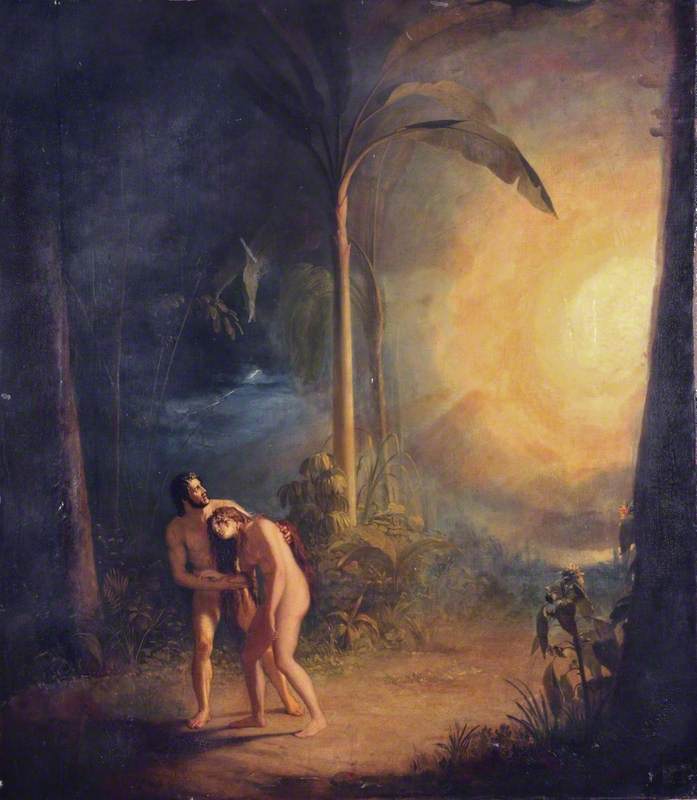
The effigy of Eve has also been likened to dozens of other prehistoric and pagan goddesses dating back to the Bronze Age, including the Hurrian goddess Khepat, the Semitic mother-goddess Asherah, and even the ancient Greek goddess of dear, Aphrodite.
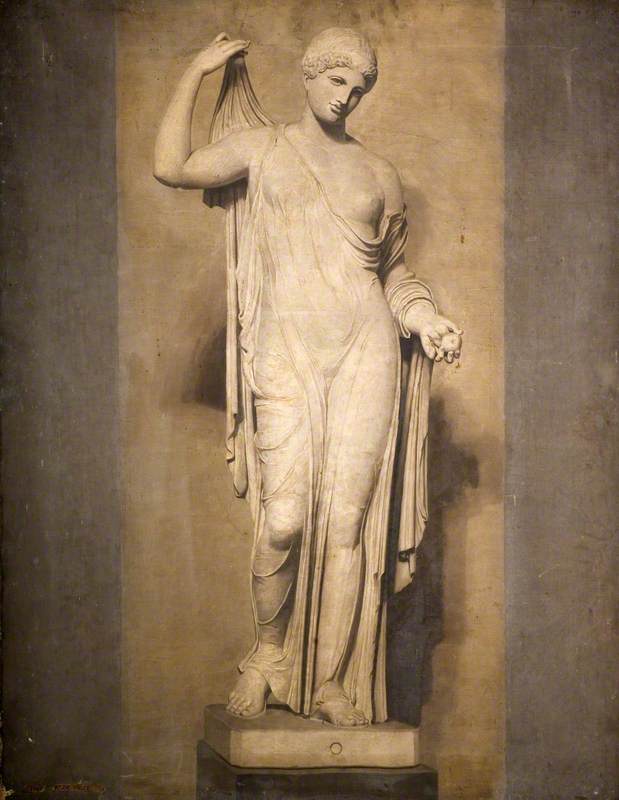
Like Eve, Aphrodite has often been depicted with an apple in her hand. In Greek myth, the story of the Sentence of Paris sees the Trojan prince Paris gift Aphrodite the golden apple.

He thus wins Helen of Sparta (who becomes Helen of Troy), simply he doesn't comprehend his fatal mistake. The seductive beauty and persuasion of women in this myth sparks the Trojan War and consequently hundreds of thousands of deaths.
Information technology is important to note that these archaic legends reflected the patriarchal times in which they were created.
Past today's standards, such stories are tainted with misogyny. The mutual thread among these narratives is that the source of arraign tends to pb dorsum to the female. Typically, this kind of fictional woman is so dangerously seductive that she persuades men to brand terrible and irreversible decisions. Would Paris have started the Trojan State of war if he hadn't been led astray by female person dazzler? Would Adam take bitten the apple if he hadn't accepted it from Eve?
For centuries, artists have offered their own interpretations of the story. Only according to Stephen Greenblatt, writer of The Rise and Fall of Adam and Eve, it was merely during the Renaissance era when new modes of representation and applied science succeeded in propagating the creation myth, bringing the story to life.
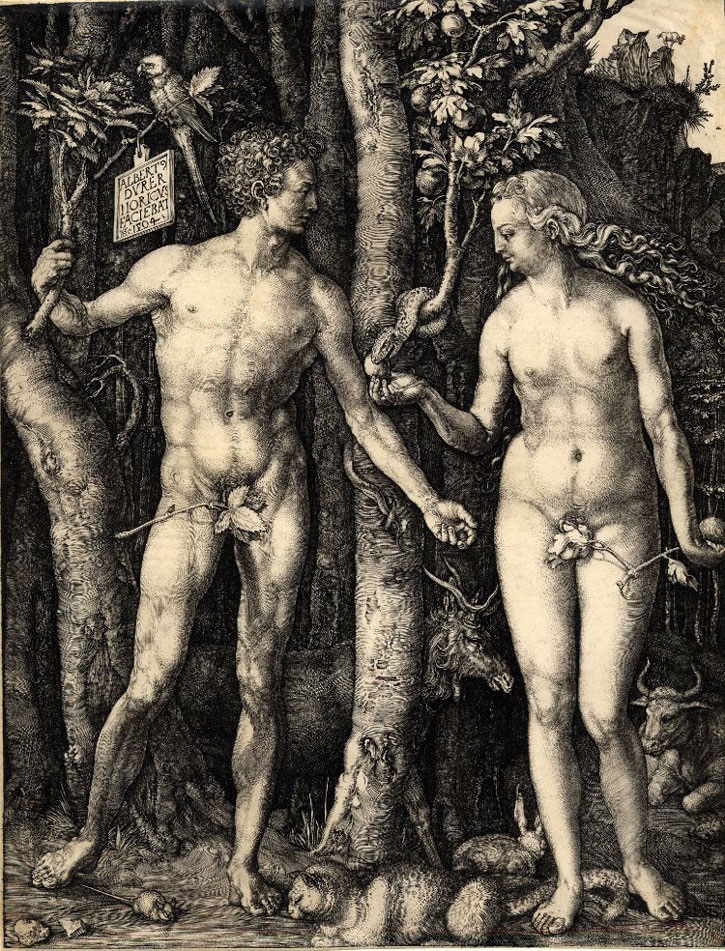
Adam and Eve
1504, engraving by Albrecht Dürer (1471–1528)
1 of the most famous portrayals of Adam and Eve is by the Renaissance German printmaker Albrecht Dürer, whose engraving was created in 1504. Dürer's depiction rapidly circulated around Europe cheers to the new medium of printing – the copperplate engraving he used could be reproduced many times over. Thousands of people in sixteenth-century Europe would take seen Dürer's powerful image and believed they were witnessing the truthful likenesses of the get-go man and adult female.
In Dürer'due south depiction, the pair flank the Tree of Knowledge as the serpent curls itself around a co-operative. The snake passes the fruit to Eve equally Adam watches passively. Eve'due south gesture is delicate and ambiguous – is she being fed the forbidden fruit? Or is she feeding Adam? Dürer was fascinated with this bailiwick and created many versions, including this large-calibration painting (which is a copy later on Dürer's original).

In 1592, Cornelis Cornelisz. van Haarlem created a very similar depiction of Adam and Eve in The Fall of Man, which can be found in the Rijksmuseum, Amsterdam (this painting also features in episode two ofKilling Eve). Scholars accept noted that in this depiction, a serpent-adult female appears in the tree and offers the fruit to Eve.
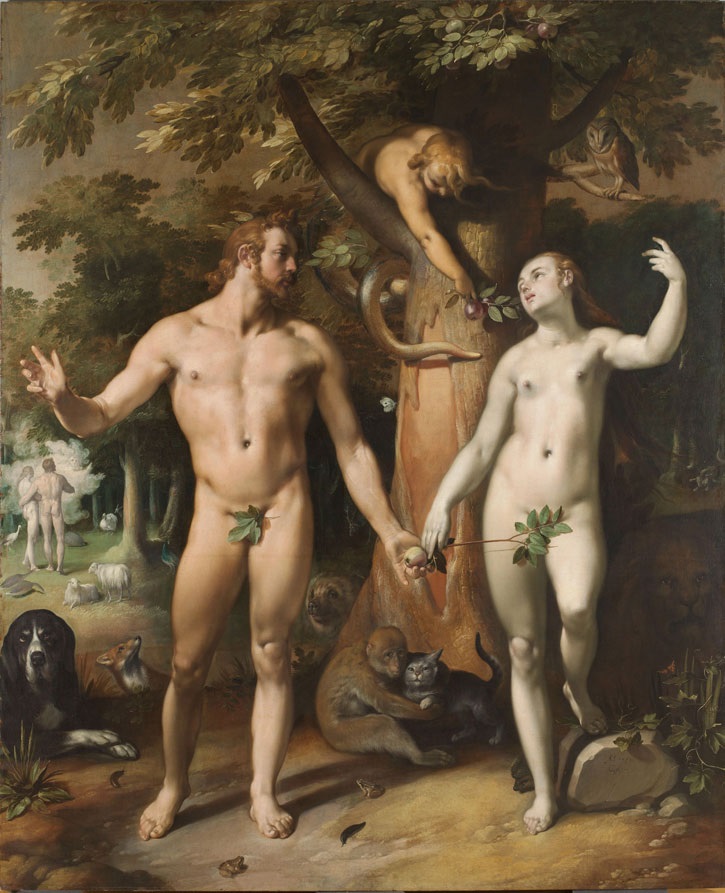
The Fall of Human being
1592, oil on canvas by Cornelis Cornelisz. van Haarlem (1562–1638)
Some other celebrated Northern Renaissance painter who was fixated with the popular discipline of Adam and Eve was Lucas Cranach the elder (1472–1552), whose famous delineation shows a befuddled-looking Adam scratching his head with defoliation as Eve passes him the fruit.

Adam and Eve 1526
Lucas Cranach the elder (1472–1553)
The Courtauld, London (Samuel Courtauld Trust)
In other sixteenth-century depictions, like this one beneath by an unknown artist of the Flemish School, the snake cannot be visibly detected, significant by implication that the culpability lies direct with Eve.
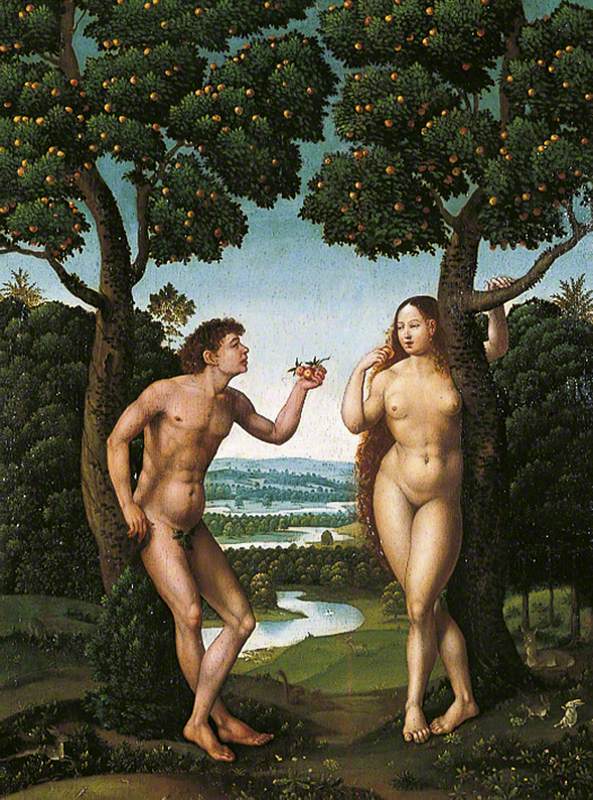
In this early seventeenth-century version named The Temptation of Adam and Eve past Joachim Anthonisz. Wtewael (1566–1638), Eve appears to directly and forcefully place the apple into the hand of Adam.
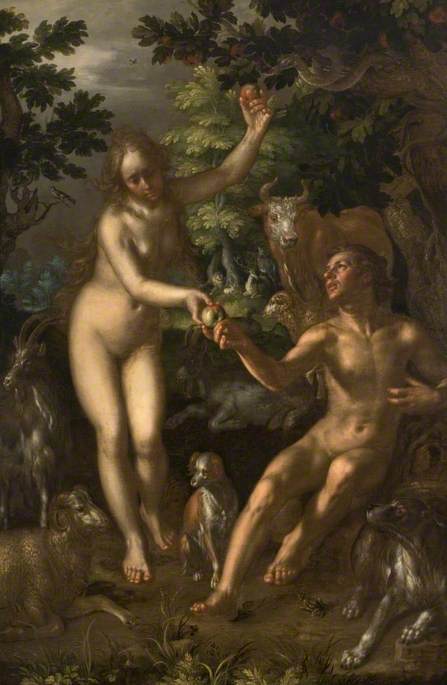
Creative person Johann König's version also depicts Eve pressing the fruit into Adam's hand. Standing above Adam, she appears as a powerful seductress.

Beyond the Biblical creation story, how has the archetype of Eve come up to represent womanhood?
The figure of Eve in the pop imagination is a coalescence of many female protagonists, both historical and fictional – from Jezebel and Medea to Pandora, Delilah and Salome. All of these well-known, 'badly behaved' women have consistently reappeared in western art history and literature. Such negative stereotypes surrounding images of womanhood arguably contributed to the persecution of 'witches', particularly in medieval and Renaissance Europe.

Jezebel 1896
John Byam Liston Shaw (1872–1919)
Russell-Cotes Fine art Gallery & Museum
In the Hebrew Bible, Jezebel is the wife of Ahab, King of State of israel, who kills the prophets of Yahweh (God). She came to be associated with the idea of 'false prophets' and evolved into the modern term 'Jezebel', an insult designated to a 'fallen woman', who was usually believed to be promiscuous or a prostitute. Similar Eve, who was interpreted as a seductress who harnassed her sexuality to gain power over Adam, other negative female stereotypes often conflate sin with sexuality. By the 1880s, the literary device and symbol of the 'femme fatale' was commonly used to denote a sex-crazed, seductive withal dangerous woman.
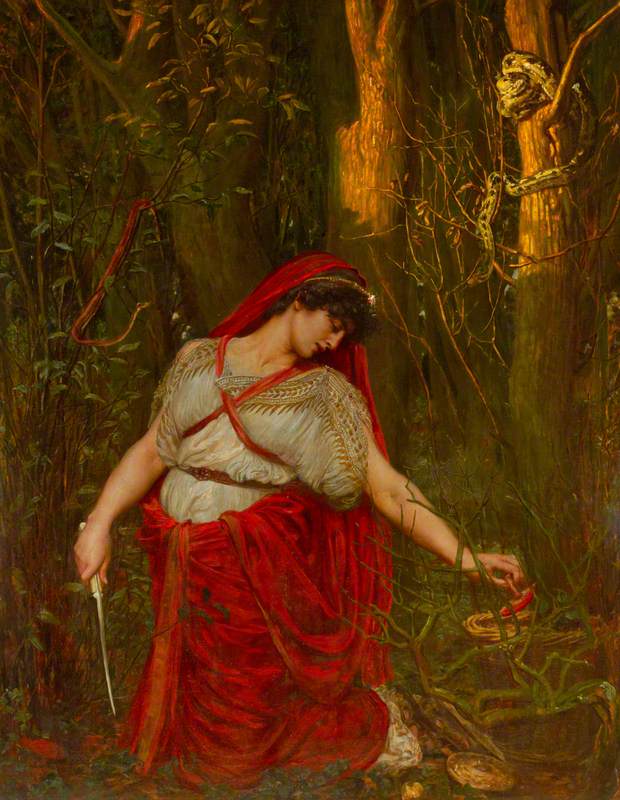
Enlightened of such historical associations, Killing Eve revels in showing a female character who has psychopathic tendencies, yet who is unashamed of her sexual appetite. Subverting the traditional heterosexual narrative even more, Villanelle and Eve are attracted to ane some other rather than the male characters.
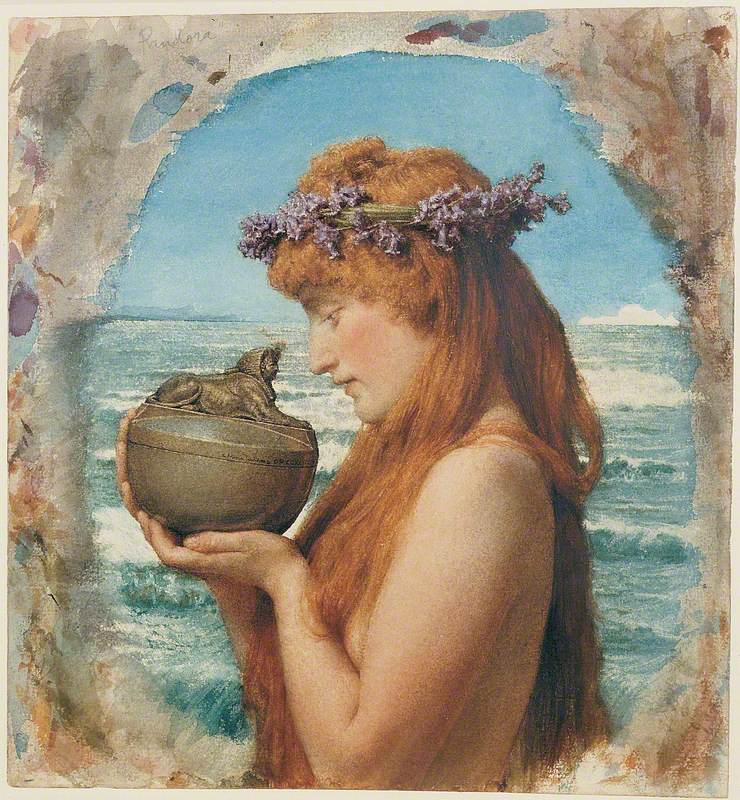
Pandora
Lawrence Alma-Tadema (1836–1912)
Majestic Watercolour Society
Why do the creation myth and the figure of Eve continue to fascinate usa?
Eve'southward story has had a more profoundly negative impact on women than any other mythological or Biblical story. For centuries, the cosmos story was used by the Church, and Christian society as a whole, to justify patriarchal attitudes and the subjugation of women.
Withal, the irony is that Eve is a contradiction. How tin can she be intentionally wicked, only as well gullible, dim-witted and weak-willed all at the same time? Still, the everlasting, symbolic power of Eve continues to saturate contemporary popular civilisation. If you are watching Expert Omens, based on the Neil Gaiman and Terry Pratchett novel, you volition notice that Adam and Eve are portrayed as black characters. This perhaps relates to the theory of the 'Mitochondrial Eve' – the first woman who could be a mutual ancestor to everyone would have been from Africa, and therefore black, rather than white, as she has been depicted throughout western art history.
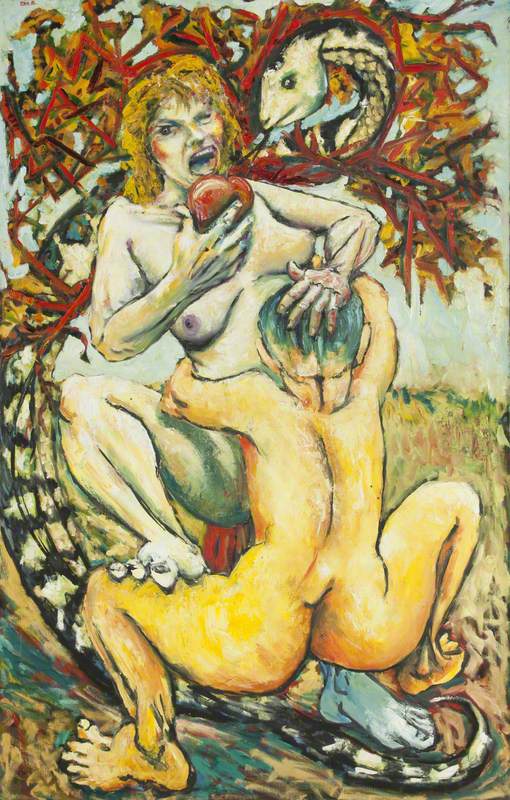
To finish this brusk fine art history on Eve, let's return to Killing Eve, a show presenting two refreshingly different female characters. In their ain ways, each woman refers dorsum to the Biblical figure of Eve. If nosotros read Killing Eve as a form of satire, Villanelle embodies the historical stereotype of the psychopathic, sex-crazed, cocky-interested and wicked woman (who seduces men with her innocent advent), while Eve Polastri is the disobedient and conflicted woman, tempted by what she is not allowed to desire. Virtually importantly, the prove represents shameless and unapologetic female person characters laughing in the confront of centuries of negative myths about women.
As regards the futurity of Eve in art, the brawl is firmly in the artists' court...
Lydia Figes, Content Creator at Art UK
More than stories
Artworks
Learning resources
Source: https://artuk.org/discover/stories/from-the-garden-of-eden-to-killing-eve-deconstructing-the-first-woman-in-art